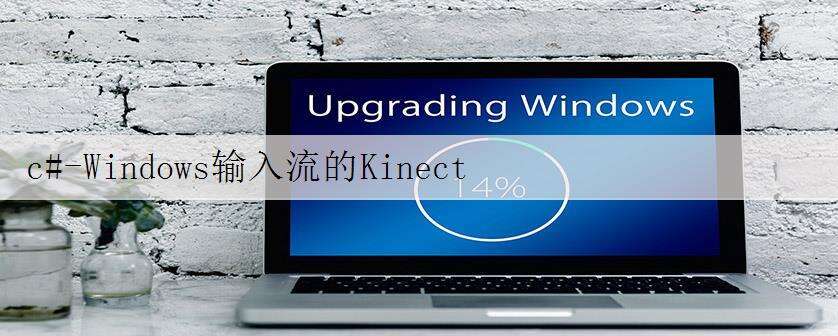c#-Windows输入流的Kinect

我基本上试图使用与SDK(ColorBasics示例)中给出的代码相同的代码,从Kinect for Windows中将其作为RGB流输入.
SDK中示例的代码如下
public partial class MainWindow : Window
{
/// <summary>
/// Active Kinect sensor
/// </summary>
private KinectSensor sensor;
/// <summary>
/// Bitmap that will hold color information
/// </summary>
private WriteableBitmap colorBitmap;
/// <summary>
/// Intermediate storage for the color data received from the camera
/// </summary>
private byte[] colorPixels;
/// <summary>
/// Initializes a new instance of the MainWindow class.
/// </summary>
public MainWindow()
{
//InitializeComponent();
}
/// <summary>
/// Execute startup tasks
/// </summary>
/// <param name="sender">object sending the event</param>
/// <param name="e">event arguments</param>
private void WindowLoaded(object sender, RoutedEventArgs e)
{
// Look through all sensors and start the first connected one.
// This requires that a Kinect is connected at the time of app startup.
// To make your app robust against plug/unplug,
// it is recommended to use KinectSensorChooser provided in Microsoft.Kinect.Toolkit
foreach (var potentialSensor in KinectSensor.KinectSensors)
{
if (potentialSensor.Status == KinectStatus.Connected)
{
this.sensor = potentialSensor;
break;
}
}
if (null != this.sensor)
{
// Turn on the color stream to receive color frames
this.sensor.ColorStream.Enable(ColorImageFormat.RgbResolution640x480Fps30);
// Allocate space to put the pixels we'll receive
this.colorPixels = new byte[this.sensor.ColorStream.FramePixelDataLength];
// This is the bitmap we'll display on-screen
this.colorBitmap = new WriteableBitmap(this.sensor.ColorStream.FrameWidth, this.sensor.ColorStream.FrameHeight, 96.0, 96.0, PixelFormats.Bgr32, null);
// Set the image we display to point to the bitmap where we'll put the image data
this.Image.Source = this.colorBitmap;
// Add an event handler to be called whenever there is new color frame data
this.sensor.ColorFrameReady += this.SensorColorFrameReady;
// Start the sensor!
try
{
this.sensor.Start();
}
catch (IOException)
{
this.sensor = null;
}
}
if (null == this.sensor)
{
this.statusBarText.Text = Properties.Resources.NoKinectReady;
}
}
/// <summary>
/// Execute shutdown tasks
/// </summary>
/// <param name="sender">object sending the event</param>
/// <param name="e">event arguments</param>
private void WindowClosing(object sender, System.ComponentModel.CancelEventArgs e)
{
if (null != this.sensor)
{
this.sensor.Stop();
}
}
/// <summary>
/// Event handler for Kinect sensor's ColorFrameReady event
/// </summary>
/// <param name="sender">object sending the event</param>
/// <param name="e">event arguments</param>
private void SensorColorFrameReady(object sender, ColorImageFrameReadyEventArgs e)
{
using (ColorImageFrame colorFrame = e.OpenColorImageFrame())
{
if (colorFrame != null)
{
// Copy the pixel data from the image to a temporary array
colorFrame.CopyPixelDataTo(this.colorPixels);
// Write the pixel data into our bitmap
this.colorBitmap.WritePixels(
new Int32Rect(0, 0, this.colorBitmap.PixelWidth, this.colorBitmap.PixelHeight),
this.colorPixels,
this.colorBitmap.PixelWidth * sizeof(int),
0);
}
}
}
/// <summary>
/// Handles the user clicking on the screenshot button
/// </summary>
/// <param name="sender">object sending the event</param>
/// <param name="e">event arguments</param>
private void ButtonScreenshotClick(object sender, RoutedEventArgs e)
{
if (null == this.sensor)
{
this.statusBarText.Text = Properties.Resources.ConnectDeviceFirst;
return;
}
// create a png bitmap encoder which knows how to save a .png file
BitmapEncoder encoder = new PngBitmapEncoder();
// create frame from the writable bitmap and add to encoder
encoder.Frames.Add(BitmapFrame.Create(this.colorBitmap));
string time = System.DateTime.Now.ToString("hh'-'mm'-'ss", CultureInfo.CurrentUICulture.DateTimeFormat);
string myPhotos = Environment.GetFolderPath(Environment.SpecialFolder.MyPictures);
string path = Path.Combine(myPhotos, "KinectSnapshot-" + time + ".png");
// write the new file to disk
try
{
using (FileStream fs = new FileStream(path, FileMode.Create))
{
encoder.Save(fs);
}
this.statusBarText.Text = string.Format("{0} {1}", Properties.Resources.ScreenshotWriteSuccess, path);
}
catch (IOException)
{
this.statusBarText.Text = string.Format("{0} {1}", Properties.Resources.ScreenshotWriteFailed, path);
}
}
}
}
我的应用程序中的代码如下
using System;
using System.Collections.Generic;
using System.Linq;
using System.Text;
using System.Windows;
using System.Windows.Controls;
using System.Windows.Data;
using System.Windows.Documents;
using System.Windows.Input;
using System.Windows.Media;
using System.Windows.Media.Imaging;
using System.Windows.Navigation;
using System.Windows.Shapes;
using Microsoft.Kinect;
namespace VideoKinect
{
/// <summary>
/// Interaction logic for MainWindow.xaml
/// </summary>
public partial class MainWindow : Window
{
private KinectSensor sensor;
private WriteableBitmap colorBitmap;
private byte[] colorPixels;
public MainWindow()
{
//InitializeComponent();
}
private void WindowLoaded(object sender, RoutedEventArgs e)
{
foreach (var potentialSensor in KinectSensor.KinectSensors)
{
if (potentialSensor.Status == KinectStatus.Connected)
{
this.sensor = potentialSensor;
break;
}
}
if (null != this.sensor)
{
// Turn on the color stream to receive color frames
this.sensor.ColorStream.Enable(ColorImageFormat.RgbResolution640x480Fps30);
// Allocate space to put the pixels we'll receive
this.colorPixels = new byte[this.sensor.ColorStream.FramePixelDataLength];
// This is the bitmap we'll display on-screen
this.colorBitmap = new WriteableBitmap(this.sensor.ColorStream.FrameWidth, this.sensor.ColorStream.FrameHeight, 96.0, 96.0, PixelFormats.Bgr32, null);
// Set the image we display to point to the bitmap where we'll put the image data
this.ColorImage.Source = this.colorBitmap;
// Add an event handler to be called whenever there is new color frame data
this.sensor.ColorFrameReady += this.SensorColorFrameReady;
// Start the sensor!
//try
//{
this.sensor.Start();
// }
// catch (IOException)
//{
this.sensor = null;
// }
}
if (null == this.sensor)
{
MessageBox.Show("No Kinect Available");
}
}
private void SensorColorFrameReady(object sender, ColorImageFrameReadyEventArgs e)
{
using (ColorImageFrame colorFrame = e.OpenColorImageFrame())
{
if (colorFrame != null)
{
// Copy the pixel data from the image to a temporary array
colorFrame.CopyPixelDataTo(this.colorPixels);
// Write the pixel data into our bitmap
this.colorBitmap.WritePixels(
new Int32Rect(0, 0, this.colorBitmap.PixelWidth, this.colorBitmap.PixelHeight),
this.colorPixels,
this.colorBitmap.PixelWidth * sizeof(int),
0);
}
}
}
}
}
但是我在代码中的“ IOException”处遇到错误,即使我在xaml文件中将图像命名为相同的图像,也未检测到图像“ ColorImage”.
解决方法:
我能够以预期的行为编译并执行上面的代码-唯一的变化是取消注释InitializeComponent();并添加< Image x:Name =“ ColorImage” />到MainWindow.xaml.
IOException到底怎么说?您能否再次检查您的Kinect传感器是否通过至少USB 2.0 bus – 1.1 has insufficient bandwidth正确连接?您还确定传感器具有足够的功率来满足kinect power supply cable的需要.您始终可以检查SDK是否正确安装,请查看此post.
关于未找到您的ColorImage重建的问题,假设XAML中Image的x:Name上没有拼写错误,解决方案应该可以解决该问题.
